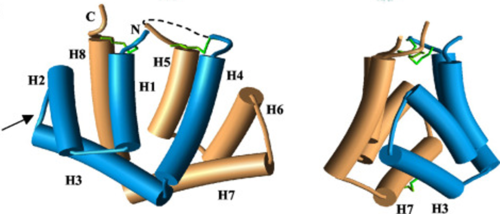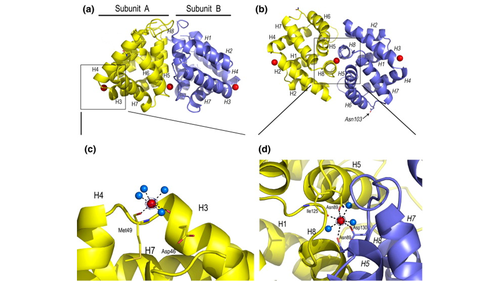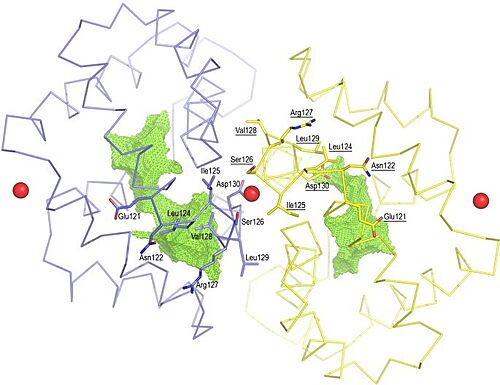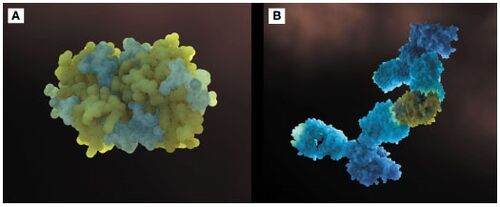Fel d 1
From Proteopedia
(Difference between revisions)
| Line 2: | Line 2: | ||
<StructureSection load='1puo' size='340' side='right' caption='Caption for this structure' scene=''> | <StructureSection load='1puo' size='340' side='right' caption='Caption for this structure' scene=''> | ||
='''Introduction'''= | ='''Introduction'''= | ||
| - | The major allergen in cats, [[Fel d 1]], belongs to the [https://en.wikipedia.org/wiki/Secretoglobin secretoglobin] family of proteins and is, worldwide, one of the major causes of allergic asthma, as it induces IgE responses in 90 to 95% of those allergic to cats and in 60 to 90% of total allergenic activity to cat hair. Symptoms range from mild rhinitis and conjunctivitis to life-threatening asthmatic responses. The structure of Fel d 1 displays the location of three previously defined Fel d 1 IgE epitopes on the surface of the protein <ref name="[1]"> PMID: 12851385 </ref>. | + | The major allergen in cats, [[Fel d 1]], belongs to the [https://en.wikipedia.org/wiki/Secretoglobin secretoglobin] family of proteins and is, worldwide, one of the major causes of allergic asthma, as it induces [https://www.ncbi.nlm.nih.gov/books/NBK27117/ IgE] responses in 90 to 95% of those allergic to cats and in 60 to 90% of total allergenic activity to cat hair. Symptoms range from mild rhinitis and conjunctivitis to life-threatening asthmatic responses. The structure of Fel d 1 displays the location of three previously defined Fel d 1 IgE [https://en.wikipedia.org/wiki/Epitope#T_cell_epitopes epitopes] on the surface of the protein <ref name="[1]"> PMID: 12851385 </ref>. |
It is produced mainly by the salivary and sebaceous glands, it is also present in the perianal, lacrimal and squamous epithelial cells and is attached to the cat's hair through the habit of licking <ref name="[1]"/><ref name="[3]">WANDALSEN, Gustavo Falbo; SANO, Flavio; SOLÉ, Dirceu. Alérgenos do gato nas alergias respiratórias: situação atual e novas perspectivas. Asma, alergia e imunologia, São Paulo, SP, Brasil, v. 4, n. 1, p. 61-71, 10 mar. 2020. doi: http://dx.doi.org/10.5935/2526-5393.20200004.</ref>. | It is produced mainly by the salivary and sebaceous glands, it is also present in the perianal, lacrimal and squamous epithelial cells and is attached to the cat's hair through the habit of licking <ref name="[1]"/><ref name="[3]">WANDALSEN, Gustavo Falbo; SANO, Flavio; SOLÉ, Dirceu. Alérgenos do gato nas alergias respiratórias: situação atual e novas perspectivas. Asma, alergia e imunologia, São Paulo, SP, Brasil, v. 4, n. 1, p. 61-71, 10 mar. 2020. doi: http://dx.doi.org/10.5935/2526-5393.20200004.</ref>. | ||
| Line 9: | Line 9: | ||
== '''Structure''' == | == '''Structure''' == | ||
| - | Fel d 1 is a tetrameric glycoprotein of 35 to 39 kDa, by size exclusion chromatography, formed by two identical heterodimers of about 18 kDa, noncovalently linked. These heterodimers are totally α-helical, formed by 8 helices, H1-H4 and H5-H8, corresponding to the | + | Fel d 1 is a tetrameric glycoprotein of 35 to 39 kDa, by size exclusion chromatography, formed by two identical heterodimers of about 18 kDa, noncovalently linked. These heterodimers are totally α-helical, formed by 8 helices, H1-H4 and H5-H8, corresponding to the 1 and 2 chains, respectively<ref name="[1]"/><ref name="[4]">GRÖNLUND H, Saarne T, Gafvelin G, van Hage M: The Major Cat Allergen, Fel d 1, in Diagnosis and Therapy. Int Arch Allergy Immunol 2010;151:265-274. doi: 10.1159/000250435.</ref>. Chains 1 and 2 are two antiparallel polypeptides, linked via 3 interchain disulfide bonds, formed between cysteine residues at positions Cys3-Cys73, Cys44-Cys48, and Cys70-Cys7, at chains 1 and 2, respectively <ref name="[1]"/><ref name="[4]"/>. Chain 1 has about 8kDa, composed of a residue of 70 amino acids and chain 2 has about 10 kDa, which can be composed of a residue of 90 amino acids, found preferably in the sebaceous glands, or composed of a residue of 92 amino acids, which is expressed by the salivary glands. Its glycan portion is found in chain 2 and the recombinant structure of Fel d 1 reveals that the N33 residue is located in the loop connecting the H2 and H3 helices and that the side chain is exposed to the solvent<ref name="[1]"/><ref name="[4]"/>. |
Revision as of 22:49, 6 December 2021
1PUO - Fel d 1: The major cat allergen
| |||||||||||




